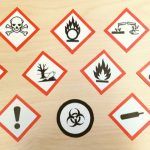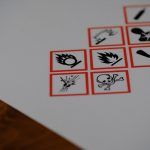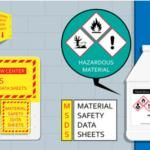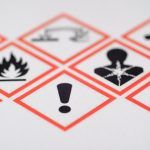
WHMIS 2015/GHS Symbols & Their Meanings
All workplaces in Canada are required to ensure their hazard labelling are in accordance with WHMIS 2015/GHS. This is necessary to bring consistency between labelling systems across the world and has been made a necessity by globalization in business. Canada’s Workplace Hazardous Materials Information System (WHMIS) has had some changes to align with the goals of the Globally Harmonized System of Classification and Labelling of Chemicals (GHS) and it would now be a good time for a refresher on what all the WHMIS 2015 symbols represent.
WHMIS/GHS PICTOGRAMS

Exploding Bomb (Explosion or reactivity hazards)
The symbol of an object exploding is used to clearly signify that the material is explosive and risks combusting when handled improperly. These materials should be handled only by professionals under safe conditions and always handled with extreme care. Proper storage of these materials is paramount as some may be sensitive to heat or light and their explosiveness poses a massive risk for serious injury or death.
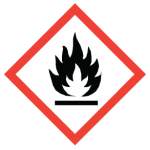 Flame (Fire hazard)
Flame (Fire hazard)
These materials or products are prone to easy ignition and can burn rapidly. They should be handled with extra care and kept away from heat and open flames at all costs. Understand that for a fire to burn it requires oxygen, heat and fuel, so these should never be brought anywhere near these materials.
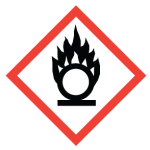 Flame Over Circle (Oxidizing hazards)
Flame Over Circle (Oxidizing hazards)
Oxidizing materials are materials that are extremely reactive to oxygen, and generate a large amount of heat when they come into contact with the element, even under mild conditions. These materials do not burn themselves, but will improve the likelihood of combustible materials around them for caching fire such as wood, textiles or other flammable materials, with lower levels of heat needed to catch fire.
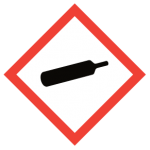 Gas Cylinder (Gases under pressure)
Gas Cylinder (Gases under pressure)
This symbol is used to identify that the gas contained in a cylinder or other similar storage device is under high pressure and will be sensitive to punctures or leaks, providing the risk of explosions or allowing the cylinder to turn into a makeshift projectile if the container is compromised. Often times the gases contained within these cylinders are hazardous themselves so other hazard labels are often accompanied by a gas cylinder label.
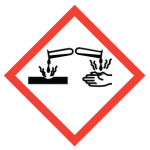 Corrosion (Corrosive damage to metals, skin, eyes)
Corrosion (Corrosive damage to metals, skin, eyes)
This signifies that the material can chemically react to materials or skin, destroying them in the process. This damage is devastating and chemicals usually react immediately on contact. Extreme caution must be taken when handling these materials with proper PPE being worn at all times when doing so. Some also have the potential to cause other adverse health effects in addition to corrosion.
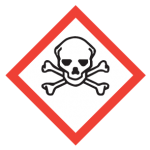 Skull & Crossbones (Can cause death or toxicity with short exposure to small amounts)
Skull & Crossbones (Can cause death or toxicity with short exposure to small amounts)
This symbol has long been associated with death and it is used in materials labelling to warn you that the relevant product has potential to be fatal, toxic, or extremely harmful even with a limited exposure. This can be exposure through contact with skin, inhalation, or swallowing and the specifics will be specified on the Safety Data Sheet (SDS). Proper handling should be taken extremely seriously with these materials.
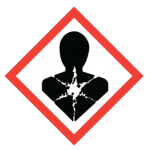 Health Hazard (May cause or suspected of causing serious health effects)
Health Hazard (May cause or suspected of causing serious health effects)
These materials will cause chronic health effects from disease, sickness, cancer, infertility, and more. While these materials if contacted may not cause serious injury or damage immediately, long term exposure without proper protection can lead to very serious chronic health conditions. Proper PPE to protect from exposure is required to safely work in the vicinity of these materials.
 Exclamation Mark (May causes less serious health effects or damage the ozone layer)
Exclamation Mark (May causes less serious health effects or damage the ozone layer)
This symbol signifies less severe health effects from exposure including irritation, inflammation, coughing etc. Effects of exposure to these materials are generally treatable and have less of risk for long term chronic health effects compared to materials under the WHMIS 2015 health hazard label. These materials should still be treated as dangerous as some individuals may be more sensitive to the effects.
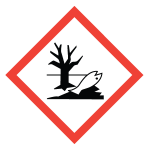 Environment (May cause damage to the aquatic environment)
Environment (May cause damage to the aquatic environment)
While this label is not mandatory in Canada, it still may appear on imported materials or from suppliers that choose to highlight these hazards. These materials should be kept out of water sources as they will harm aquatic life and lead to toxic impacts to the environment in those settings. These materials can also make their way into homes if treatment plants aren't equipped to remove them, so they are important to keep these materials out of water sources.
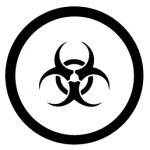 Biohazardous Infectious Materials (Organisms or toxins that can cause diseases in people or animals)
Biohazardous Infectious Materials (Organisms or toxins that can cause diseases in people or animals)
This iconic symbol signifies that the material contains organisms harmful to our health by causing disease or other serious illnesses. These organisms include bacteria, viruses, fungi and parasites. This symbol will also be placed on containers for medical waste. Handling biohazardous materials requires extensive PPE including hazmat suits. The risks associated with biohazardous materials are serious and if you fear you have been exposed, seek medical attention immediately.
Borders
Borders are applied to consumer products to help identify dangerous materials. There are two types:
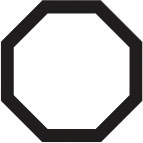
Octagon
This boarder simply means that the contents are dangerous and should be handled with care.
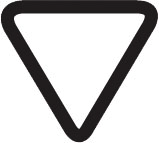 Upside down triangle
Upside down triangle
This means that the container itself can be dangerous. A word will accompany this symbol indicating the severity of the risk. CAUTION means injury may be temporary, but still has the potential for death if exposure is extreme. DANGER means the product may cause permanent damage to health and body. EXTREME DANGER means that even a small or limited exposure can result in permanent injury or death.
ADVANCED CONSULTING & TRAINING OFFERS WHMIS 2015/GHS TRAINING
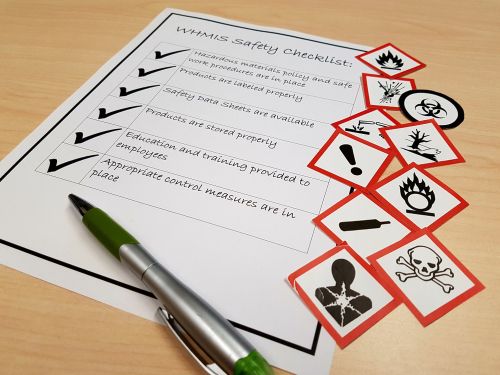 A safe work place is crucial and ensuring that you have the right safety procedures and policies for things such as WHMIS 2015/GHS, first aid, CPR, confined space entry, and more can create a great work environment that is both safe and productive. Since Advanced Consulting and Training Ltd.’s founding, their diverse team of certified health and safety professionals have taken great pride in their ability to deliver prompt, cost-effective and relevant workplace health and safety solutions. As a CPO approved, TSSA accredited, and WSIB approved provider, we look forward to discussing how ACT can help with your company’s safety requirements. Contact us today for WHMIS 2015/GHS safety training.
A safe work place is crucial and ensuring that you have the right safety procedures and policies for things such as WHMIS 2015/GHS, first aid, CPR, confined space entry, and more can create a great work environment that is both safe and productive. Since Advanced Consulting and Training Ltd.’s founding, their diverse team of certified health and safety professionals have taken great pride in their ability to deliver prompt, cost-effective and relevant workplace health and safety solutions. As a CPO approved, TSSA accredited, and WSIB approved provider, we look forward to discussing how ACT can help with your company’s safety requirements. Contact us today for WHMIS 2015/GHS safety training.
Frequently Asked Questions
WHMIS stands for Workplace Hazardous Materials Information System. It is a comprehensive plan for providing information on the safe use of hazardous materials used in Canadian workplaces. Product labels, material safety data sheets (MSDS), and worker education initiatives are used to disseminate information. WHMIS was created to guarantee the security of employers and workers while they are working. The system was specifically created to notify employees and employers of the risks and dangers related to the chemicals and substances they might be exposed to at work.
The main components of WHMIS are hazard identification and product classification, labelling, material safety data sheets, and worker training and education.

